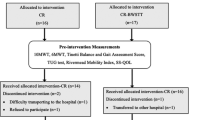Abstract
The purpose of this study was to clarify the application range and utility of an ADL index for disabled elderly people (Demura et al., 2000), by examining the ADL characteristics of an elderly population when this index was applied to disabled and independent elderly people. Subjects of this study were 697 Japanese institutionalized disabled elderly people and 482 independent elderly people (ID) living at home. Disabled elderly people were classified into four groups based on condition of use of assisting devices for movement; D1 did not use assisting devices; D2 used a stick or a walker; D3 used a wheelchair; D4 was immobile. From the findings of comparing achievement proportions, ADL score and the distribution of total score among elderly groups, it was suggested that this ADL index can assess gradually from disabled elderly people who cannot move to independent elderly people. Since this index classifies independent elderly people and disabled elderly people with high probability, it can evaluate if elderly people can maintain a functional level needed for independent living, and can recognize the symptoms of disability. Furthermore, this study proposed useful activities to discriminate the functional level for each elderly group. Although it is important to comprehensively assess ADL ability, further use of this ADL index to discriminate the functional level of an elderly population, by making use of these useful activities, is expected.
Similar content being viewed by others
References
Demura S, Sato S, Kobayashi H, Kasuga K, Toyoshima Y. Development of ADL index for partially dependent older adults. Japanese Journal of Public Health 1999; 46: 25–34.
Demura S, Sato S, Minami M, Kobayashi H, Noda M. The proporsal of the activities of daily living (ADL) index for institutionalized older adults. Japanese Journal of Hygiene 2000; 55–3: 538–546.
Etoh F, Tanaka M, Chishima M, Igarashi M, Mizoguchi T, Wada H, Iijima S. Comprehensive activities of daily living (ADL) index for the elderly. Japanese Journal of Geriatrics 1992; 29: 841–848.
Hosokawa T, Tsubono Y, Ysuji I, Maesawa M, Nakamuta R. Assessment of functional status with an extended ADL scale (1): A general population sample of community elderly, Japanese Journal of Rehabilitation and Medicine 1994; 31: 399–408.
Katz S, Ford AB, Moskowitz RW, Jackson BA, Jaffe MW, Cleveland MA. Studies of illness in the aged, The index of ADL: A standardized measure of biological and psychosocial function. JAMA 1963; 12: 919–919.
Keith RA, Granger CV, Hamilton BB, Sherwin FS. The functional independence measure: a new tool for rehabilitation. In: Eisenberg MG and Grzesiak RC, editors. Advances in clinical rehabilitation vol.2., New York, Springer, 1987; 6–18.
Kempen GIJM, Suurmeijer JPBM. The development of a hierarchical polychotomous ADL-IADL scale for noninstitutionalized elders. Gerontologist 1990; 30: 497–502.
Kempen GIJM, Myers AM, Powell LE. Hierarchical structure in ADL and IADL: analytical assumptions and applications for clinicians and researchers. J. Clin. Epidemiol. 1995; 48: 1299–1305.
Lawton MP, Brody EM. Assessment of older people: self-maintaining and instrumental activities of daily living. Gerontologist 1969; 9: 179–186.
Mahoney FI, Barthel WD. Functional evaluation: The Barthel Index. Maryland state Medical Journal 1965; 14: 61–65.
Reuben DB, Laliberte L, Hiris J, Mor V. A hierarchical exercise scale to measure function at the advanced activities of daily living (AADL) level. AGS 1990; 38: 855–861.
Shoening HA, Iversen IA. Numerical Scoring of Self-care Status: A Study of Kenny Self-care Evaluation. Arch. Phys. Med. Rehabil. 1968; 49: 221–229.
Spector WD, Katz S, Murphy JB, Fulton JP. The hierarchical relationship between activities of daily living and instrumental activities of daily living. J. Chron. Dis. 1987; 40: 481–489.
Sato S, Demura S, Kobayashi H, Goshi F, Minami M, Nagasawa Y, Yamaji S. Characteristics of ADL ability on partially dependent older adults: comparison among different ambulatory activities levels. Applied Human Science 1999; 18: 169–174.
Demura S, Sato S, Minami M, Toyoshima Y, Goshi F, Ishikawa Y. Characteristics of activities of daily living (ADL) ability in institutionalized disabled older adults: comparison according to usage conditions of assisting devices for movement. Japanese Journal of Physiological Anthropology 2000; 5–1: 1–8.
Author information
Authors and Affiliations
Corresponding author
Rights and permissions
About this article
Cite this article
Demura, S., Sato, S. & Minami, M. Utility of an ADL index for institutionalized elderly people: Examining possible applications for independent elderly people. Environ Health Prev Med 6, 33–40 (2001). https://doi.org/10.1007/BF02897307
Received:
Accepted:
Issue Date:
DOI: https://doi.org/10.1007/BF02897307




